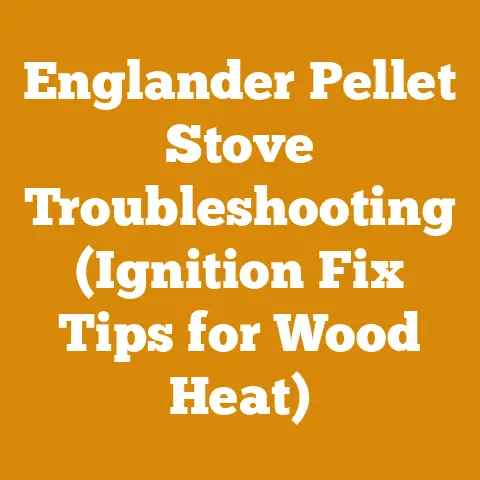How Hot Does a Wood Stove Pipe Get? (5 Pro Tips for Safety)
Imagine a cozy winter evening, the scent of woodsmoke filling the air, and the gentle crackle of a fire in the wood stove. It’s a scene that evokes warmth and comfort. But for a child, especially, that warmth can be deceptively dangerous. The allure of the glowing flames can draw them closer than they should be, unaware of the intense heat radiating not only from the stove itself, but also from the stove pipe that carries the smoke and heat up and out of the house. That pipe, seemingly innocuous, can reach temperatures hot enough to cause severe burns in an instant.
That’s why understanding how hot a wood stove pipe gets is absolutely crucial, not just for your comfort, but for the safety of everyone in your home, especially the little ones. I’ve spent years working with wood stoves, from installing them to troubleshooting problems, and I’ve seen firsthand the damage that can result from a lack of knowledge and precautions. This guide isn’t just about technical specifications; it’s about protecting your family and ensuring that your wood-burning experience is safe and enjoyable.
Let’s dive into the specifics, starting with the numbers and then moving into practical tips to keep your home safe.
How Hot Does a Wood Stove Pipe Get? (5 Pro Tips for Safety)
The question of how hot a wood stove pipe gets is not a simple one. It depends on various factors, including the type of wood you’re burning, the stove’s design, the burn rate, and the type of stove pipe itself. However, understanding the temperature ranges is the first step in ensuring safety.
Understanding Temperature Ranges
Generally, a single-wall stove pipe can reach temperatures between 250°F and 900°F (121°C and 482°C). Double-wall stove pipes are designed to mitigate this heat, but they still reach considerable temperatures, typically between 250°F and 500°F (121°C and 260°C).
Here’s a breakdown of what these temperatures mean:
- 250°F – 400°F (121°C – 204°C): This is a moderate temperature range, but still hot enough to cause burns upon contact. At this range, creosote is more likely to condense, increasing the risk of chimney fires.
- 400°F – 700°F (204°C – 371°C): This is a high temperature range, indicating a hotter fire. While it can lead to efficient burning, it also increases the risk of overheating and potential damage to the stove or pipe.
- 700°F – 900°F (371°C – 482°C): This is a very high temperature range and can be dangerous. It suggests an overfired stove, which can damage the stove, warp the pipe, and significantly increase the risk of a chimney fire.
Data Point: Studies show that the risk of chimney fires increases exponentially when flue temperatures consistently exceed 500°F (260°C). Regularly monitoring flue temperatures with a magnetic thermometer is critical.
Factors Influencing Pipe Temperature
Many factors influence how hot your wood stove pipe gets. Understanding these will help you manage your fire more effectively and safely.
- Type of Wood: Hardwoods like oak and maple burn hotter and longer than softwoods like pine and fir. Using seasoned (dry) wood is crucial. Wet wood requires more energy to burn off the moisture, resulting in lower stove temperatures initially but can lead to increased creosote buildup.
- Technical Specification: Firewood moisture content should be below 20% for optimal burning and reduced creosote formation. I use a moisture meter religiously to ensure my wood is properly seasoned. I once made the mistake of burning wood with a moisture content of around 30%, and I could immediately tell the difference in the burn quality and the amount of smoke produced. It took much longer to get the stove up to temperature, and I had to clean the chimney more frequently that season.
- Airflow: Increasing airflow to the firebox increases the burn rate and temperature. Most stoves have air controls to regulate this.
- Stove Design: Different stove designs have different efficiencies and heat outputs. Some stoves are designed to radiate heat more efficiently, while others focus on convection.
- Stove Pipe Type: Single-wall pipes radiate more heat into the room but are also more prone to creosote buildup. Double-wall pipes provide better insulation and reduce the risk of creosote.
- Chimney Draft: A strong chimney draft can pull heat away from the stove more quickly, affecting the overall pipe temperature.
Pro Tip #1: Invest in a Reliable Thermometer
The first and most crucial step is to invest in a reliable stove pipe thermometer. There are two main types:
- Magnetic Thermometers: These attach directly to the stove pipe and provide a surface temperature reading. They’re easy to install and read.
- Probe Thermometers: These are inserted into the stove pipe and provide a more accurate reading of the flue gas temperature.
I prefer magnetic thermometers for their ease of use and quick readings, but a probe thermometer provides more precise data. Regardless of which type you choose, make sure it has a clear, easy-to-read display.
Technical Detail: When installing a magnetic thermometer, place it about 18 inches (45 cm) above the stove on the single-wall pipe. This location gives a representative reading of the flue gas temperature without being too close to the stove body’s radiant heat.
Pro Tip #2: Burn Seasoned Wood Only
Burning seasoned wood is not just about efficiency; it’s about safety. Green or wet wood burns inefficiently, producing more smoke and creosote. Creosote is a highly flammable substance that can accumulate in the chimney and cause a dangerous chimney fire.
- Wood Selection Criteria:
- Moisture Content: As mentioned earlier, aim for a moisture content below 20%.
- Type of Wood: Hardwoods like oak, maple, and ash are ideal.
- Seasoning Time: Allow wood to season for at least six months, preferably a year, in a well-ventilated area. I’ve found that splitting the wood before seasoning significantly reduces the drying time.
- Visual Inspection: Seasoned wood will be lighter in color, have cracks in the end grain, and sound hollow when struck against another piece of wood.
Personal Experience: I once thought I could get away with burning wood that had only been seasoning for about four months. Big mistake. The fire was sluggish, the smoke was thick, and I ended up with a significant creosote buildup in my chimney.
Data Point: Burning unseasoned wood can reduce the efficiency of your wood stove by as much as 50% and increase creosote production by up to 400%.
Pro Tip #3: Control Your Airflow Wisely
Airflow is the key to controlling the burn rate and temperature of your wood stove. Most stoves have primary and secondary air controls.
- Primary Air: This control regulates the air entering the firebox from below or through the front of the stove. Opening the primary air control increases the burn rate and temperature.
- Secondary Air: This control introduces air into the upper part of the firebox, promoting more complete combustion of the gases released by the wood.
Best Practices:
- Start with the air controls fully open: This helps to establish a good draft and get the fire going quickly.
- Once the fire is established, gradually reduce the primary air: This will slow down the burn rate and maintain a steady temperature.
- Adjust the secondary air to achieve clean combustion: You should see minimal smoke coming from the chimney.
- Never completely shut off the air supply: This can lead to smoldering fires, increased creosote production, and a risk of carbon monoxide poisoning.
Case Study: I once helped a friend troubleshoot his wood stove, which was constantly overheating. After inspecting the stove, I discovered that the primary air control was stuck in the open position. This was allowing too much air into the firebox, causing the fire to burn uncontrollably. Once we fixed the air control, the stove operated much more efficiently and safely.
Pro Tip #4: Regular Chimney Inspections and Cleaning
Regular chimney inspections and cleaning are essential for preventing chimney fires. Creosote buildup is the primary culprit, and even a thin layer can ignite under the right conditions.
- Inspection Frequency: The National Fire Protection Association (NFPA) recommends that chimneys be inspected at least once a year, even if they are not used regularly.
- Cleaning Frequency: The frequency of cleaning depends on how often you use your wood stove and the type of wood you burn. As a general rule, if you burn wood regularly, you should clean your chimney at least once a year. If you burn a lot of softwood, you may need to clean it more often.
Technical Requirements:
- Professional Inspection: A qualified chimney sweep can perform a thorough inspection of your chimney, identifying any potential problems such as cracks, blockages, or excessive creosote buildup.
- DIY Cleaning: If you’re comfortable cleaning your chimney yourself, you’ll need the right tools, including a chimney brush, extension rods, and a vacuum cleaner.
Safety Equipment Requirements:
- Eye Protection: Wear safety glasses to protect your eyes from falling debris.
- Dust Mask: Wear a dust mask to avoid inhaling creosote particles.
- Gloves: Wear gloves to protect your hands from dirt and creosote.
Personal Story: I remember one year I put off cleaning my chimney for too long. When I finally got around to it, I was shocked at how much creosote had accumulated. There was easily a quarter-inch layer of hard, tarry creosote coating the inside of the chimney. It was a wake-up call, and I’ve made it a priority to clean my chimney regularly ever since.
Pro Tip #5: Maintain Proper Clearances
Maintaining proper clearances around your wood stove and stove pipe is crucial for preventing fires. The heat radiating from the stove and pipe can ignite nearby combustible materials.
- Clearance Requirements:
- Stove: Most wood stoves require a minimum of 36 inches (91 cm) of clearance from combustible walls and ceilings. However, this can be reduced by using heat shields.
- Stove Pipe: Single-wall stove pipes require a minimum of 18 inches (45 cm) of clearance from combustible materials. Double-wall stove pipes require less clearance, typically 6 inches (15 cm).
Technical Details:
- Heat Shields: Heat shields are non-combustible barriers that are installed between the stove or pipe and combustible materials. They reduce the amount of heat radiating from the stove or pipe, allowing you to reduce the clearance requirements.
- Wall Protection: Wall protection can be achieved using various materials, including brick, stone, metal, or specially designed heat-resistant panels.
Visual Examples:
- Diagram of Stove Clearances: (Include a diagram showing the minimum clearance requirements for a wood stove and stove pipe.)
- Example of Heat Shield Installation: (Include a photo or diagram showing how to install a heat shield behind a wood stove.)
Practical Tips:
- Consult the stove manufacturer’s instructions: Always follow the manufacturer’s instructions for clearance requirements.
- Err on the side of caution: If you’re unsure about the clearance requirements, it’s always better to err on the side of caution and provide more clearance than is required.
- Regularly inspect clearances: Check the clearances around your stove and pipe regularly to ensure that nothing has been moved too close.
Data Point: Studies have shown that improper clearances are a leading cause of residential fires involving wood stoves.
Additional Safety Measures
Beyond the five pro tips, there are other measures you can take to enhance wood stove safety.
- Install Smoke Detectors and Carbon Monoxide Detectors: These detectors are essential for alerting you to a fire or carbon monoxide leak. Make sure they are properly installed and maintained.
- Technical Specification: Smoke detectors should be installed on every level of your home and outside of sleeping areas. Carbon monoxide detectors should be installed near sleeping areas.
- Keep a Fire Extinguisher Nearby: Have a fire extinguisher rated for Class A fires (ordinary combustibles) readily available near the stove.
- Never Use Flammable Liquids to Start a Fire: Use only approved fire starters or kindling to start a fire. Never use gasoline, kerosene, or other flammable liquids.
- Supervise Children and Pets: Keep children and pets away from the stove, especially when it is in use. Consider installing a safety gate around the stove to prevent accidental contact. I remember a close call when my toddler got too close to the stove. Thankfully, I was right there to pull him away, but it was a terrifying moment that reinforced the importance of constant supervision.
- Ensure Proper Ventilation: Make sure your home is properly ventilated to prevent the buildup of carbon monoxide.






